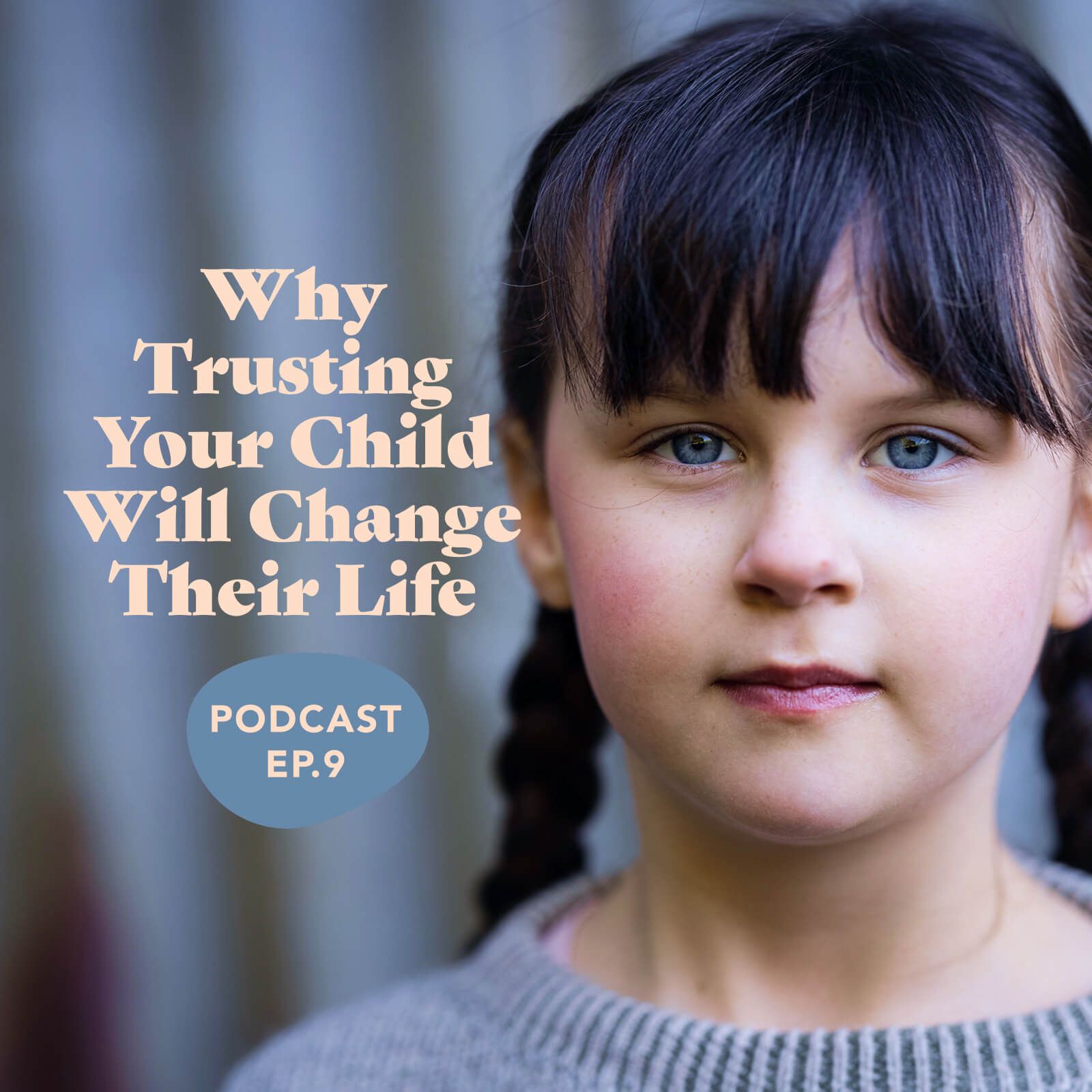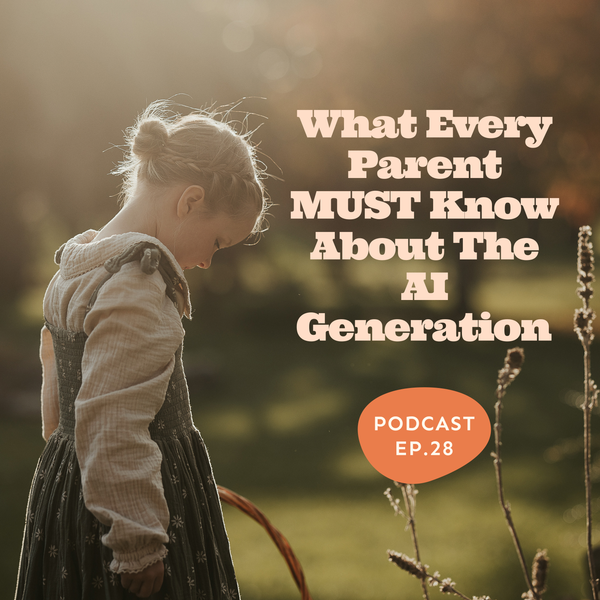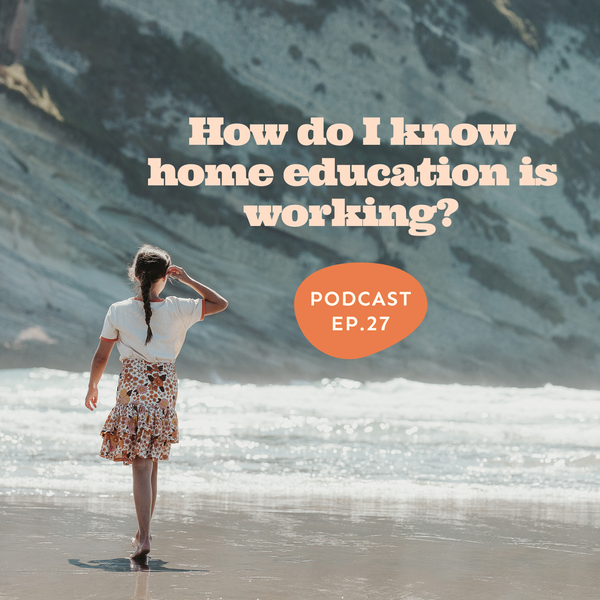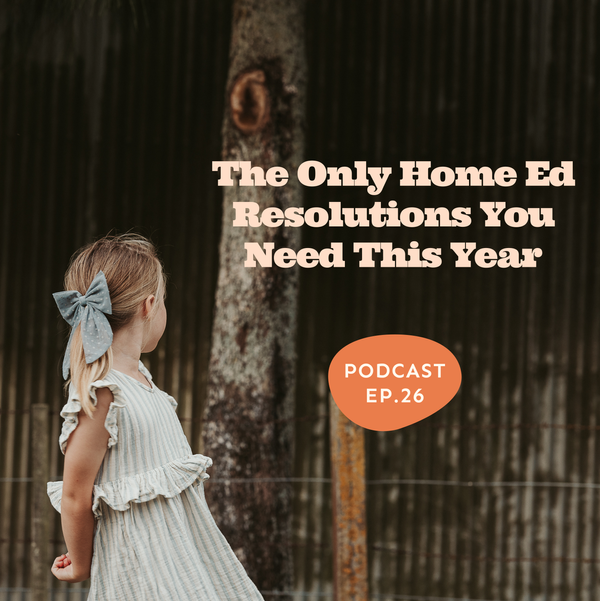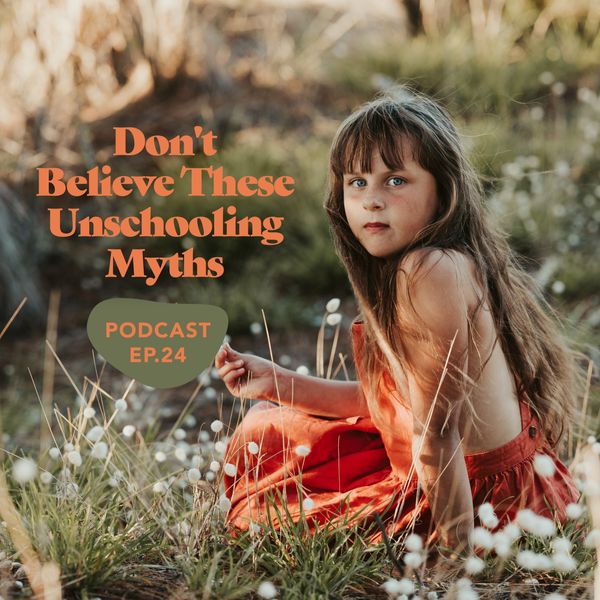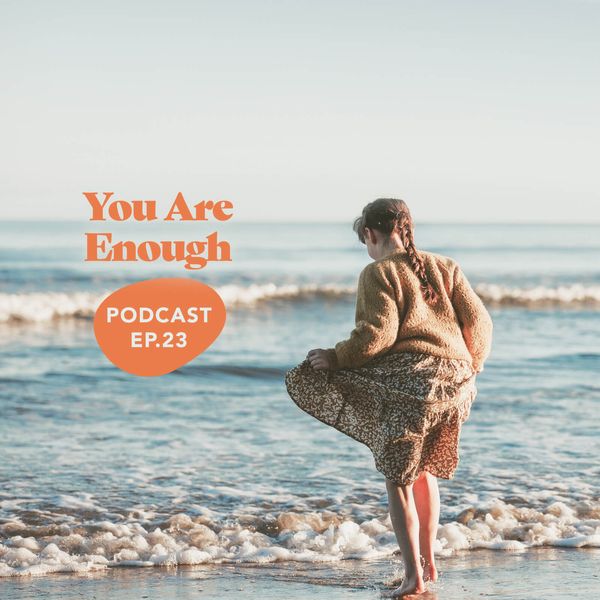In this episode we’re looking at a philosophy that underpins how Kate and I approach life with our kids, their education, and our relationships with them. It’s very different to the way formal education is approached, and is based on the power of trust.
We’ll talk about the process of letting go of that complete control over a child’s education that is so engrained in us. About why it’s so important, how we might navigate it all, and what the results can look like.
About how putting trust in our children has changed our lives. And, how I believe it can change yours, too.
These private episodes go even deeper, backed by research, the science of how children learn and grow, and more than a decade of lived home educating experience. Each one is designed to help you rethink, reframe, and recalibrate the way you're walking this path, giving you the confidence to live the version of life you want. The Collection is 23 episodes strong and counting, with over 10 hours of listening available right now.
As a subscriber, you'll also get immediate access to my self-paced course, expert-led masterclasses recordings, five downloadable guides, our school exemption documents, and more 💛
Show Notes
The hole in the wall: self organising systems in education: https://www.researchgate.net/publication/50993473_The_hole_in_the_wall_self_organising_systems_in_education
The child-driven education (Sugata Mitra TED Talk): https://www.ted.com/talks/sugata_mitra_the_child_driven_education/transcript?language=en
William’s Youtube channel! https://www.youtube.com/channel/UCW4K1TBtSZ3EB6oeFJfuMTw
Complete Transcript
INTRO
Helloooo and welcome to the Life Without School podcast, here to help you and your children live the life you want to, not just the one you’re told you should.
I’m Issy, a writer and unschooling dad from New Zealand.
You can find more about me at starkravingdadblog.com, as well as collections of my favourite posts bundled up into encouraging little guidebooks for anyone walking this road less travelled.
Thank you so much for tuning in to listen today. Alright, let’s get into this week’s episode.
MUSIC
Hello again! I hope you’re well, wherever you’re tuning into this episode from.
The topic for today actually came out of a question a lot of you asked for last week’s Q&A episode, but when I started jotting down thoughts about it I realised it really needed a whole episode to do it justice.
Paraphrased, the question is… “Should I just let go of all those normal pressures, and trust my children. Trust…that they will direct their own learning?”
This is something I’ve been asked consistently over the past few years. Every time I share a snippet from our days that involves something that’s clearly child-led – like my 11 year old on his piano or baking on his own, or my 14 year old illustrating or writing a story clearly with passion, or my 7 year old knee deep in making her next little film, I’m asked…how? How did you get to that point where your children are grabbing hold of what they’re interested in and spending deep, quality time on it?
And my answer is by trusting them.
So, this entire episode will be dedicated to the power of trust. We’ll talk about the process of letting go of that complete control over a child’s education that is so engrained in us. About why it’s so important, how we might navigate it all, and what the results can look like. About how putting trust in our children has changed our lives. And, how I believe it can change yours, too.
Alright, let’s get into this very important, and I hope very empowering, conversation.
MUSIC
We live in a world where, educationally, at least, we don’t place a lot of trust in children. We tell them what they’ll be learning, when they’ll be learning it, and where they’ll be learning it. We tell them how and when we’re going to measure their success in that learning, and we make the consequences of not being successful very clear. In most educational settings, for children of most ages, there is effectively no scope whatsoever to contribute significantly to the path their learning journey will follow.
And it’s not just the obvious stuff where it’s the adults deciding everything for the child. It’s not just the specifics on the what’s and when’s. There’s a lot of subtle messaging that sits under all that, too, that stack up over the years.
Picture a group of children in a classroom. One of them approaches their teacher and asks if they could have help with memorising a few of the facts they’ve been asked to learn. An approach that is widely used before tests, and just as widely known to be very good at increasing scores and very poor at achieving any real understanding or longterm retention. The teacher, of course, is quite comfortable helping with those rote drills if it means better scores. That will help show that their teaching has been effective.
After that short discussion ends, another child approaches the teacher. They also have a question – I never remember most of what I’ve been taught anyway, so could I please just copy from people around me to get the right stuff down and move on? The teacher, of course, says absolutely not.
Why? Both those things achieve the same result – a correctly written answer or a good score on a test, without any real gains in the child’s understanding of whatever the topic is. But the adult holds the keys to what is an acceptable way to navigate that, and what is not. That quite creative child, attempting to find the most efficient solution to the problem in front of them, would be scolded. They would be asked to go straight back to their desk and get on with that rote learning. The only two choices they have in that situation would be to listen to that instruction, or to face the consequences of not.
That is, there is no choice.
At the heart of all this is the idea we adults carry that children aren’t particularly competent. That adults very much are, and so we will make all learning decisions for them.
We simply cannot trust them to choose the right things to learn, when they should learn them, how they should learn them, and when they should move on to the next thing.
So as well as instructing them to do all this, in what way and in what order, we test them. We must test them.
We test that they’ve listened to us, followed our instructions, retained what we’ve asked them to, and repeated it back to us in a way that satisfies our requirements. We can’t leave all that up to them.
But the irony of testing – mostly another topic for another day, but it ties into this trust thing so let’s touch on it briefly – is that it absolutely destroys creativity and (for most people) performance. Yes, it is true that if someone is already good at something, they will often lift their game when being tested or analysed. But if you’re not already excelling – if you are in the middle, or – worse, struggling – your performance is more likely than not to be lower than what you’re actually capable of.
Psychologically, it’s quite obvious when you think about it. If someone of authority is standing over you, assessing you, it makes you nervous. It makes you sweat. It can make you stumble and trip. It pushes your brain into a state that couldn’t be further from relaxed, and open, and creative. And the more that’s riding on the assessment, the more all of that is elevated. Tell me – would you do your best work if your boss stood over you watching you do it?
When we put all these unnatural parameters around learning – not just by testing, but in everything we’re telling children to do – we push those parameters into a child’s brain. We tell them how to think about problems, and what boxes to work within, because that’s where they’ll need to operate to arrive at the answer or end point we’re expecting. That we’ve decided, on their behalf, is important. They know this.
They know what we expect, and they will try their best to get there.
But by not trusting them we’ve turned their own brain’s physiology against them. We don’t ask them if they’re interested in what we’re telling them to learn about. We don’t ask them if they’re physically comfortable in the space and environment we’re telling them to do it from. And we don’t ask them if the method we’re using to teach them fits how they like to learn. We break every physiological rule for the best conditions for learning, and instead tell them exactly how to think about a problem and exactly how to get to the solution we’ve told them to.
Parameters, rules, guidelines, and instructions. The opposite of trust.
Now, if all this was working, if it was successful, if everyone was thriving, that approach would be understandable. Happy days.
But it’s not successful. Deciding that we won’t trust children to help shape their educational journey, deciding that they are not competent and that adults must make every single decision for them, is not working.
That’s quite plain to see in the growing rates of anxiety and depression among children and teenagers.
It’s plain to see in the statistics around job satisfaction in adults. Midlife crises. Therapy bills.
It’s plain to see in the answer you’ll get from most adults when you ask them whether or not they enjoyed maths at school.
And it’s plain to see on the face of every child who can’t fit, or keep up with our plans.
MUSIC
So let’s talk about the powerful difference between a child spending a life under that sort of instruction, pressure and mistrust…and a life where they actually have a say.
Let’s talk about what it would look like to bring them in on the conversation about their learning journey. To invite them to help us design the educational path that will take them towards their unfolding life goals.
Let’s talk about what it would look like to trust children.
At the heart of this side of things is the fact that when you choose to do something, you will give it more energy, explore more of your potential, and do better at it, than when you are made.
That is the case for almost everything, ranging from small trivial things right through to really important stuff. And that’s the key, here – a child discovering something they really love, something they’re really passionate about, very rarely comes through force, or coercion. Or because we as adults want them to.
Those discoveries happen through feeling free to explore. From being able to follow whatever path you want into something, and turning onto different ones whenever you choose to. They happen when there is no specified goal to reach, within a specified time, in a specified way.
All good learning happens this way. And when I say good, I mean learning that has relevance to the person acquiring it. Learning that means something to them, and their life. Learning… that sticks.
In 1999, Sugata Mitra – the science director of an educational technology firm in India – set up an experiment called the Hole in the Wall. You might have heard of this. It was a computer that he’d installed on the outside wall of a building – picture a bank’s ATM machine, it was a bit like that – in one of the poorest slums in New Delhi – a place where almost no one had ever even seen a computer before, let-alone a used one. This experiment – which tied into something called MIE, or Minimally Invasive Education – was simple. Turn on the computer, connect it up to the internet – and keep in mind it’s running in English – and let the children of the area know they could play with it whenever they wanted. Using a security type camera that he left on, he tracked what the children did with the computer over a period of time. He wanted to see if they could teach themselves to use the thing. It’s a fascinating piece of research, and you should definitely look it up sometime for a bit more of a read – I’ll link to some more about Mitra, including one of his TED talks, in the show notes – but the short story of what happened is that the children very quickly learned how to use it. They worked together, they communicated and shared their learnings and progress, and within days these children were using it to create art, and play music and games, and browse the internet. And, of course, they had to teach themselves whatever English they needed to do it.
As the experiment was repeated in different parts of India – literally in hundreds of different areas of the country – all sorts of interesting things happened. Children were…learning how to read. They were finding their way to interesting articles and resources. They were expanding their spoken vocabulary. In the Rajasthan desert, children had found the sound recorder and were singing songs and playing them back to themselves within four hours.
Now, after this, the experiment got really interesting. Mitra went to Hyderabad, a big city in Southern India, where he walked into one of hundreds of schools there that were focused on teaching English. And they were succeeding – the children leaving these schools could write in English, and their spelling and grammar was great, but their accents – were the accents of their local teachers. And that accent, apparently, is very hard to understand when it’s paired with English. That meant these children were struggling to get the jobs they wanted when they got older.
So Mitra trains – what would have been relatively basic in those days, in the early 2000s – a speech-to-text program on a computer to understand a very neutral English accent only. He gives the computer to a group of children in one of these schools, shows them the speech-to-text function, and tells them he’s going to leave it with them for a couple of months. They test it while he’s standing there, and it can’t understand them at all – it just prints a bunch of nonsense words back at them. Mitra has a laugh with the children, says they’ll have to make themselves understood to the computer but that he has no idea how they might do that – which was true – and leaves. The children were confused, but fascinated.
So – what do they do? They download software. They download films. They download music. They download a speaking English Oxford dictionary, which wouldn’t have even been widely known as existing in those days. But they found one. And they started to practice and refine their accents. They worked together, and they taught themselves to speak in the accent the computer needed to be able to understand them. When Mitra returned, these children had completely altered the way they spoke. Self-led, motivated internally, with the freedom to explore, the children had done what they set out to do.
Across all these experiments came significant computer literacy, the learning of a different language, accent nuance within that language, growth in written and spoken vocabulary, reading ability, and a whole stack of collaboration and creativity. This rapid learning did not come from adult instruction. It did not come from being taught. It came from curiosity. It came from children playing, and communicating with each other. It came from having time and space to explore something they found interesting, at a pace they set, down paths they defined.
And it changed their lives.
MUSIC
I have – unknowingly – performed this same kind of experiment. With a slightly ignorant variation at the start of it. When my son William was 8, we bought a keyboard. One of those electric piano keyboard. It was a pretty basic one – inexpensive, didn’t have amazing sound, but we were living in a different country for a while, and my wife was desperately missing her childhood piano back home. It…filled the gap without breaking our shaky bank balance.
We set the keyboard up in a corner of our lounge, and William showed an immediate interest in it. So, with her music and teaching degrees, and accomplished piano playing ability – Kate sat down with him to teach him a few things. Scales, finger positioning, things like that. But no – he quickly decided it wasn’t his thing at all. We tried to help him find his way on it a few more times, before just accepting he wasn’t into it. Piano just…wasn’t his thing.
But a couple of weeks later, we woke to what sounded like a party happening in our lounge. William had found those tinny preset songs they load into those keyboards, and was flicking his way through them with the volume absolutely maxed. We kind of glanced at each other, and…left him to it. He made his way from that to a little pre-built lesson the keyboard in it – something we’d never noticed. It was incredibly basic – no speaking or guidance or anything fancy, just notes that you had to listen to and then play back. He had a bit of a play around with that, and then turned it off and walked away.
The next day, he did the same thing again…taking that self-led lesson a little bit further. Rinse, repeat. By the end of that week, he’d moved past those basic little lessons into one of the two or three complete songs the keyboard taught. And he was playing it right through, without any guidance. It was a gimmicky sort of song, on a cheap keyboard, but it just might be the most beautiful thing I’ve ever heard.
On his own steam, he then decided he was confident enough in his ability to make those keys work to try replicating some of his favourite songs. He put some Andy Grammar on Spotify, hit play, and started working out the notes.
If you’ve seen my Instagram stories of William – who is now 11 – playing his mother’s piano, or his Youtube channel where he’s started sharing his covers – you’ll know he’s made some serious progress. It is not an understatement to say that he’s a seriously accomplished pianist. At 11 years of age.
And, you need to remember that this is a child who we had just pulled out of the school system because his teacher had made the statement that he was slow, unmotivated, and lacking basic comprehension. That he’d never be able to sit still long enough to learn anything. She, of course, was referring to his ability to be taught. Which, is what schools measure a child on. We disagreed, chose a different measure, and the rest is history.
Going back to the title of this episode – the point to my story about William and his piano is that he has discovered a lifelong passion – something that is completely part of him now, and the way that he expresses himself to the world – that we would absolutely have blocked, and prevented from happening, had we pushed on with trying to teach him.
Trusting him, trusting his ability to explore and learn on his own terms, has literally changed his life.
Another slightly different example of this within my own family is my daughter, Florence. She’s 7 years old, and – brace yourselves – cannot read. She absolutely loves stories – and we read together every night – but up until recently, despite our gentle prompts and encouragement to explore, she’s shown almost no interest in actually reading herself. But a couple of months ago, she appeared beside my desk with a new Fancy Nancy book we’d picked up from the library. She wanted to tell me alllll about the story she’d just finished reading on her bed. Now, her version wasn’t the same as the one in the book, of course – she couldn’t actually read. But a significant shift had happened – she had decided, of her own accord and under no pressure, that she was ready for the challenge of reading these stories herself.
Two months later, and I can’t say she’s suddenly reading fluently yet – but the openness is there, her brain is firing with interest, and she’s ready to be coached by us towards competence, which is something she has decided she needs. It is fertile learning ground that we can help her develop, and she is making progress in something that’s genuinely important to her. Not just us.
What we’ve learned – not just through reading wonderful example’s like Mitra’s work in India, but through our own experiences in our own family – is that when children aren’t picking something up that we’re asking them to, aren’t receiving what we’re trying to get them to receive, it’s usually not that they don’t have the ability to.
It’s because they don’t have a good internal reason to learn it yet. Because when they do, watch out.
From the moment we are born, we are curious. We want to know more about the world around us. We want to explore, and discover, and learn. If you’ve ever watched a baby, and then a toddler, explore the world around them – like I’m sure most of you listening have – you couldn’t stop them if you tried. Curiosity oozes from everything they do. And you didn’t have to teach them for that to happen. In fact, you don’t have to teach them to do anything they learn when they’re young. Walking, jumping, running, talking, eating, singing…these are major life skills that are picked up through watching, mimicking, trying, failing, trying again…I’m sure you were there for them when they needed you. I’m sure you role modelled. I’m sure you encouraged. But I’m also sure you didn’t teach.
The child…learned. And they, as I so often say, are very different things.
MUSIC
To close out this episode, I want to read one of my short posts that hits to the heart of the life-changing aspect of trust. Of the difference between asking a child to live a life filled with instructions and rules, and a life grounded in choice. This short post is not just a bunch of fluffy words. It captures the essence of the struggle so many children face every day, and the very clear path parents can take to lead them out of it.
It goes like this:
Imagine a childhood built on a foundation of choice and meaning, not instruction and compliance.
A childhood with time and space to follow your interests and passions down rabbit holes. A childhood where you have a say in the depth and breadth you explore them to, a say in when you do and don’t. A say in when you’ll leave something behind and try something new.
Imagine a childhood free of measures, benchmarks, tests, grades and comparisons.
Imagine a childhood where your opinion matters. Your opinion on how your days are structured. On the physical spaces you spend your time. On what people you regularly interact with, and don’t.
On the overall direction your life is heading.
On your purpose.
Now imagine the impact such a childhood would have on self-worth. Self-discovery. Self-identity. Self-confidence. On the pace of life. On personal fulfilment. On the unacceptable levels of anxiety and stress our children are experiencing. On the alarming rates of teenage depression.
I’m often asked why on earth we’d go to all the trouble of ‘trying to teach our children ourselves’, but that’s not why we’re doing this at all. The learning, for us, is secondary at best.
No. We’ve chosen this path to set their spirits free.
Thank you, as always, for listening. I’ll see you back here soon.
Bye for now.


